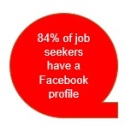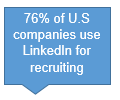In a recent study conducted by the Farmer School of Business, the Miami University Career Services office and the talent acquisition directors of Bloomberg’s 2015 Top Places to Launch a Career, it was found that 40% of large employers and 15 % of smaller organizations utilize computer-based screening when seeking potential job candidates.
As a recent college graduate, and young professional who fell in stride with millions of other Americans seeking full time careers right out of school, the constant resume editing and application submitting became all too familiar. Then I found myself in an interview in a Human Resources department, interviewing to be an HR Assistant. I got the job, now I need the experience. Here is what I have found: the digital age has a significant impact on the recruiting and hiring process; decreasing the amount of personal connection job seekers have with employers and lowering the custom er service aspect with recruiters.
er service aspect with recruiters.
Individuals seeking employment and the social media revolution are combining to inevitably become one force. Employers are seeking individuals such as college graduates, experienced workers and individuals with large skill sets that are technologic literate in every aspect of their daily routines. With this, the use of technology and information and new media has created a whole new virtual world of finding employment in which both the candidate and employer must adapt to fit both their needs.
My experience in Human Resource Management thus far consists of the usage of technical and non technical skills- utilizing systems via online and on paper. Through the computer-based screening systems as the study conducted by Farmer School of Business, the Miami University Career Services office and the talent acquisition directors of Bloomberg’s 2015 Top Places to Launch a Career indicated, the experiences on both ends of the spectrum to showcase how difficult it is to both find employment when all you have is an electronic resume and how to in turn, keep a personal client connection with potential candidates who fit the job description.
It seems technology and information has blurred the personal connection between job seekers and perspective employers, yet it has also become apparent that without technology, finding the best candidates for the job is nearly impossible.
As a recent college graduate and current employee in a Human Resource department I am constantly online utilizing databases, recruiting programs, reference checkers and social media outlets to find potential candidates for current positions. However, I have found that through the use of the technology and applications used in my department that the personal connection and utilization of customer service has ceased to exist since information has become so readily available at the swipe of a screen.
Due to this decline in personalization, finding the best candidates for a position proves to be more difficult and job seekers have much more to prove that a resume in order to get the first interview. With technology and is social media and technology information hurting candidates in the job seeking world?
To begin answering this question, one has to analyze all sides of the issue. Th at is, the advantages along with the disadvantages of technology today.
at is, the advantages along with the disadvantages of technology today.
The Huffington Post writer, Josh Tolan’s discusses the conundrum in his article “4 Ways Technology Is Changing the Job Search” (2013), which lists technological tools that find a better way for hiring managers and recruiters to connect with candidates on a personal level rather than perusing the internet for a resume. Tolan (2013) states, how the “importance of technology when it comes to finding and hiring the best people” is necessary by all means and by not utilizing technology, “your competition is likely to be scooping up the talent your company needs to succeed.” Therefore, although technology has nearly eliminated face to face interaction- it is also a necessary part of the job search in today’s virtual world.
Karen Isaacson and Sarah Peacy (2012) of KPMG, wrote an article on Human Resources and Social Media and the information individuals should know about “the opportunities and risks for your workforce.” KPMG, an  international organization that “delivers a globally consistent set of multidisciplinary services based on deep industry knowledge” provides literature with practical tools and knowledge to help organizations develop and understanding of their clients.
international organization that “delivers a globally consistent set of multidisciplinary services based on deep industry knowledge” provides literature with practical tools and knowledge to help organizations develop and understanding of their clients.
Human Resource recruiting and hiring utilizes social media very heavily, particularly in today’s society. The article, “Human Resources and Social Media” (2012) provides the following statistics: “84 percent of job seekers have a Facebook profile, and 48 percent of them have done at least one job-hunting activity on Facebook in the past year” (3). Connecting individuals seeking careers and staffing partners, social media is a key element to do this. In addition to Facebook, Twitter and LinkedIn also prove to be critical in generating the personal connection in a faceless employment world.
Twitter and LinkedIn have bec ome valuable practical tools that allow one to join recruiting chats and retweet articles and news stories that provide tips and open discussions for entry-level college graduates and HR recruiters.
ome valuable practical tools that allow one to join recruiting chats and retweet articles and news stories that provide tips and open discussions for entry-level college graduates and HR recruiters.
Technology and information in today’s digital age have changed the way Human Resource professionals will recruit and how candidates will job seek forever. Isaacson and Peacy (2012) solidify the power of technology for job seekers and recruiters by stating how they connect ideas, concepts and individuals, “organizations now have the ability to utilize knowledge from external audiences around the globe that they could never reach before” (12).
Reflection
It is my responsibility to provide my readers the production of original content. By utilizing my personal experience as an HR professional and creating the foundation of credible sources with valuable information, I am able to do this.
By researching credible resources and including direct citations, I am incorporating ethical writing principles in the creation of my article. By using unbiased information and reporting to the best of my ability I am not only providing a resource for readers to have, but I am hopefully informing extended audiences of why I am credible to discuss this topic and here is why.
To verify sources of information used in my article, I read all content thoroughly here, I reflected back on the Helpful Hints to Help You Evaluate the Credibility of Web Resources, utilized in Module 3 of COMM510: Knowledge and New Media. Here, I practiced responsible and ethical journalism by demonstrating my reliability to readers.
By computing each scholar and reporter’s name in a secure search engine, I aimed to seek first, the reporter or scholar’s education background and their peer-reviewed literature that followed. The following pieces of work by each writer proved that the sources used are accurate and their claims of information can be supported by scholarly research and reporting.
The credible sources used analyzed the important facets and purpose behind my article. By discussing industry issues today and identifying opportunities for businesses, KPMG has lengthy credibility on why their writers, Issacson and Peacy (2012) are credible sources to discuss a topic that aide’s organizations and departments like mine to utilize technology positively while maintaining that efficiency it is used best for. This source is beneficial when discussing the trials and tribulations of social media for a job seeker and on the opposing end, recruiter, but also provides solutions on how to improve that connection when there is information overload.
Tolan (2013) is the CEO of Spark Hire, which is a video network that connects job seekers and potential employers through an online base that prides the same connection as a face to face interview would. This network gives Tolan (2013) the credibility in my article because he has the experience and background to discuss the virtual space between employers and candidates, yet provides solutions on how to better serve both parties in a technological atmosphere.
Isaacson and Peacy (2012) and Tolan (2013) prove to be valuable resources because all provided the practical tools and information that discuss technology in the job seeking world and how it could improve by taking particular steps to reach audiences at the information speed we see today, while bringing that personal connection back into focus.
When it comes to technology and employers: is it possible to maintain a personal candidate connection in a faceless employment world? The answer, yes. Technology has become an integral part of the digital age we live in today- both job seekers and HR recruiters must adapt to this new form of employment and employing. With social media providing new and innovative ways to connect on a personal level, the probability of a connection is still there, you just need to apply.
For More Information
About KPMG. (2015). Retrieved November 8, 2015, from http://www.kpmg.com/us/en/about/pages/default.aspx
Deloittle CIO Journal. (2013). Why Employers Should Treat Job Seekers Like Customers. CIO Journal. Retrieved from http://deloitte.wsj.com/cio/2013/11/19/why-employers-should-treat-job-seekers-like-potential-customers/
Eadicicco, L. (2015). LinkedIn’s top talent executive shares her best career advice for college graduates. Business Insider. Retrieved November 28, 2015 from http://www.businessinsider.com/how-to-get-a-job-out-of-college-linkedin-2015-5
Helpful Hints to Help You Evaluate the Credibility of Web Resources. (1988). Retrieved November 15, 2015, from http://mason.gmu.edu/~montecin/web-eval-sites.htm
Huckabee, M. The Undercover Recruiter (2015). Are College Graduates in HR Setting Their Sights Too High? [Web log post]. Retrieved from http://theundercoverrecruiter.com/are-college-graduates-in-hr-setting-their-sights-too-high/
Isaacson, K., & Peacy, S. (2012). Human Resources and Social Media. Retrieved November 8, 2015, from https://www.kpmg.com/US/en/IssuesAndInsights/ArticlesPublications/Documents/human-resources-social-media.pdf
Korach, S. (2015). What employers really look for in recent college graduates. USA Today. Retrieved November 29, 2015 from http://college.usatoday.com/2015/07/22/hiring-recent-college-graduates/
Schlesinger, J. (2015). For job seekers, the hunt is increasingly digital. CBS News. Retrieved from http://www.cbsnews.com/news/why-being-on-social-media-can-help-you-land-a-job/
Tolan, J. (2013). 4 Ways Technology is Changing the Job Search. The Huffington Post. Retrieved from http://www.huffingtonpost.com/josh-tolan/4-ways-technology-is-chan_b_2736375.html.
